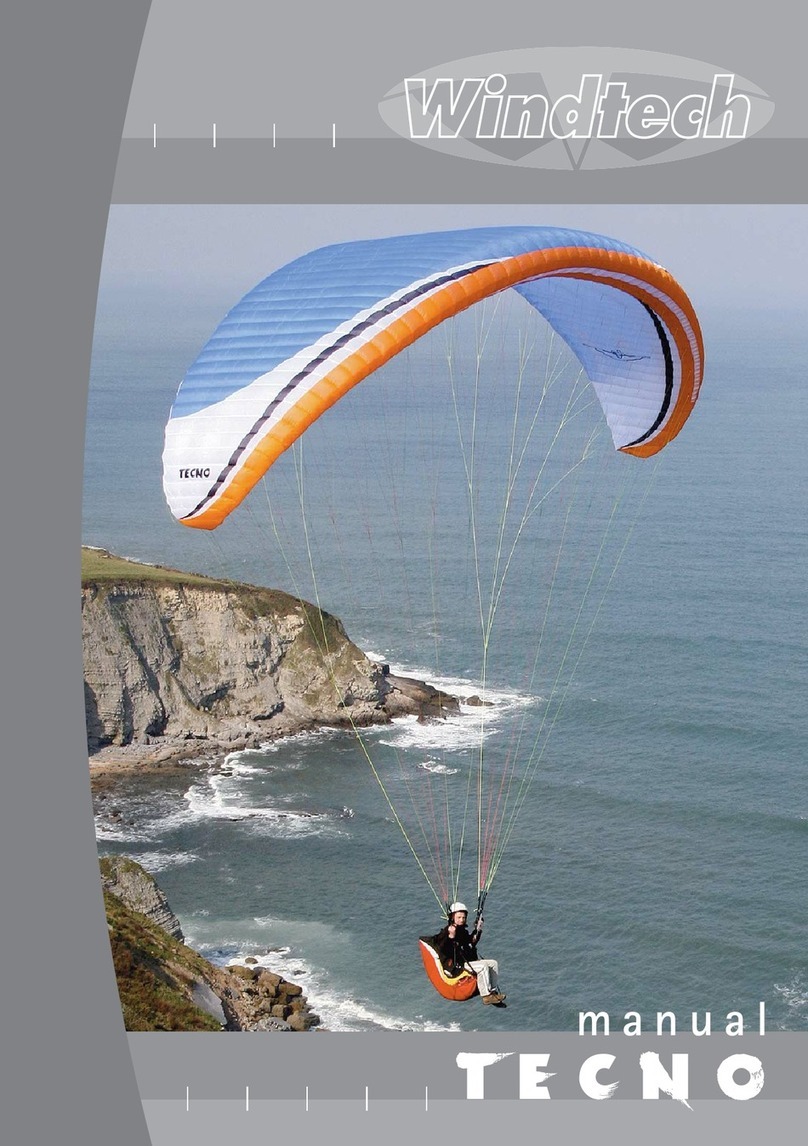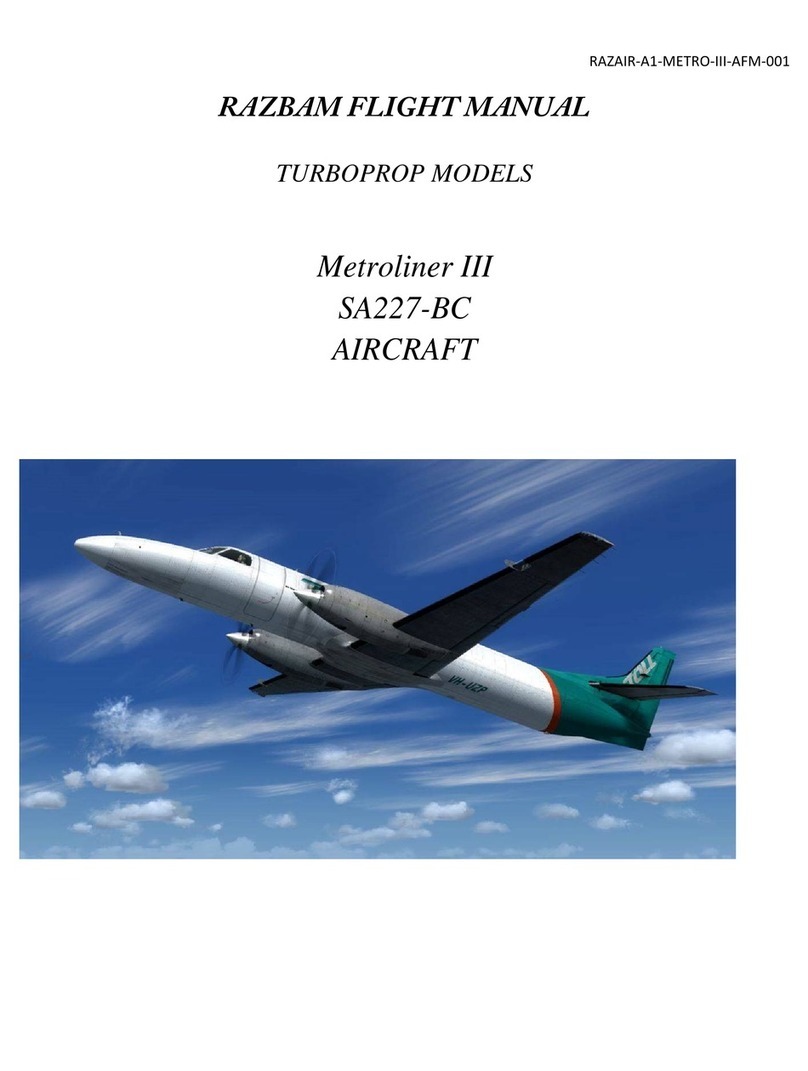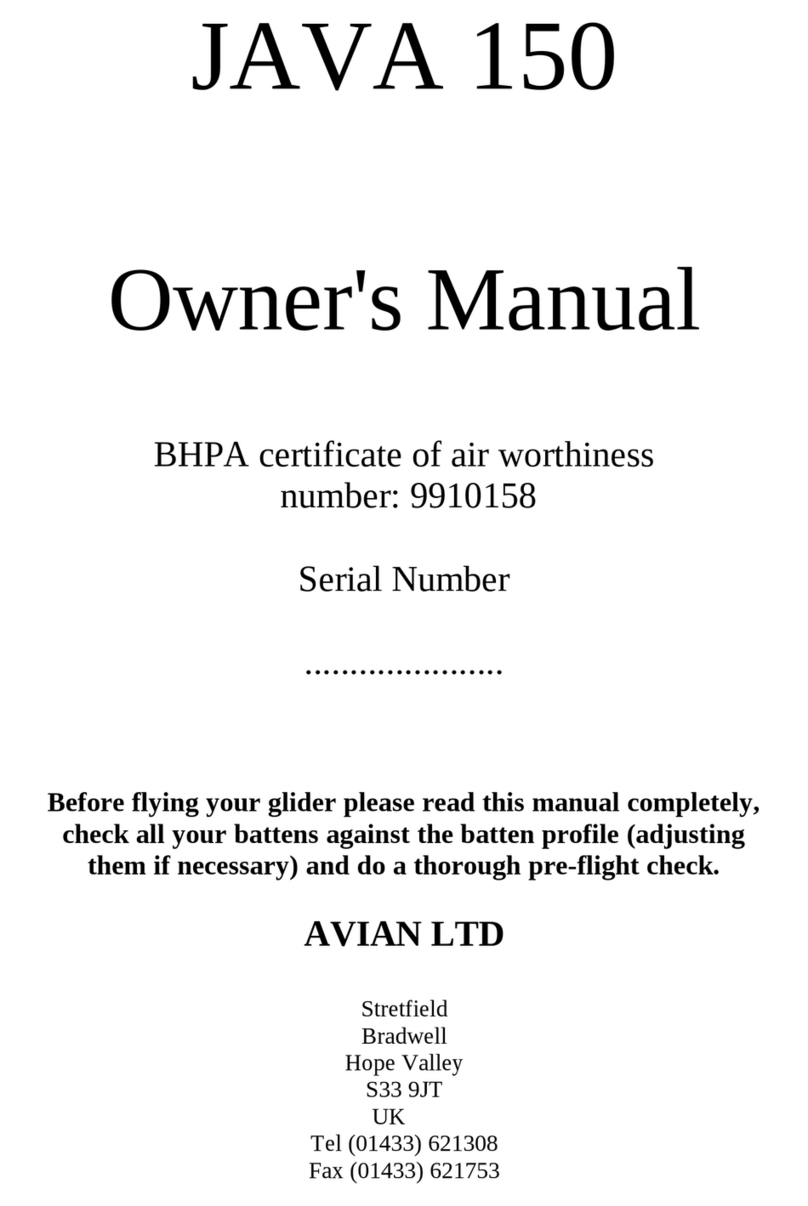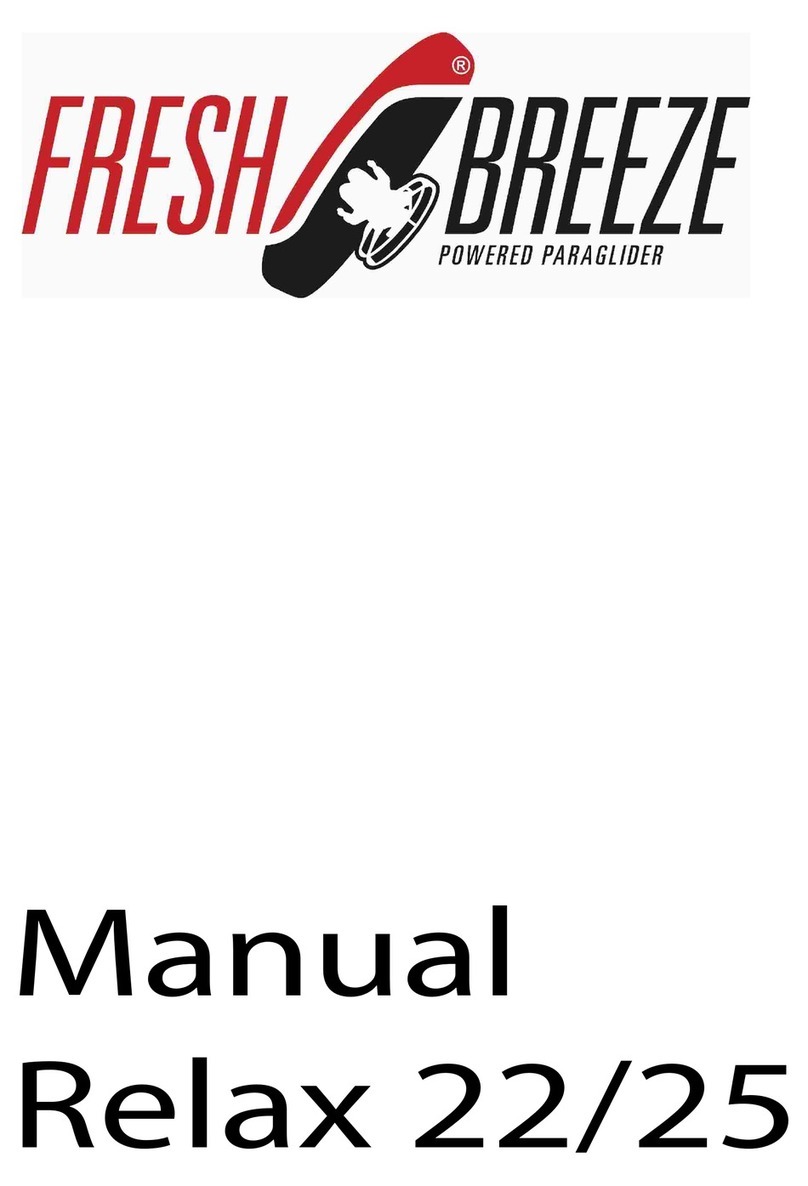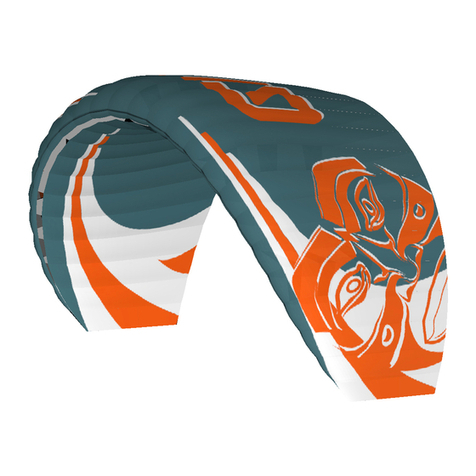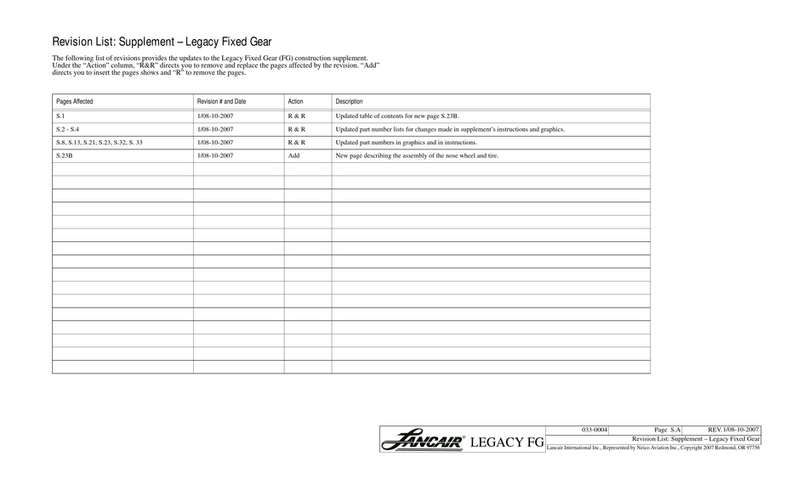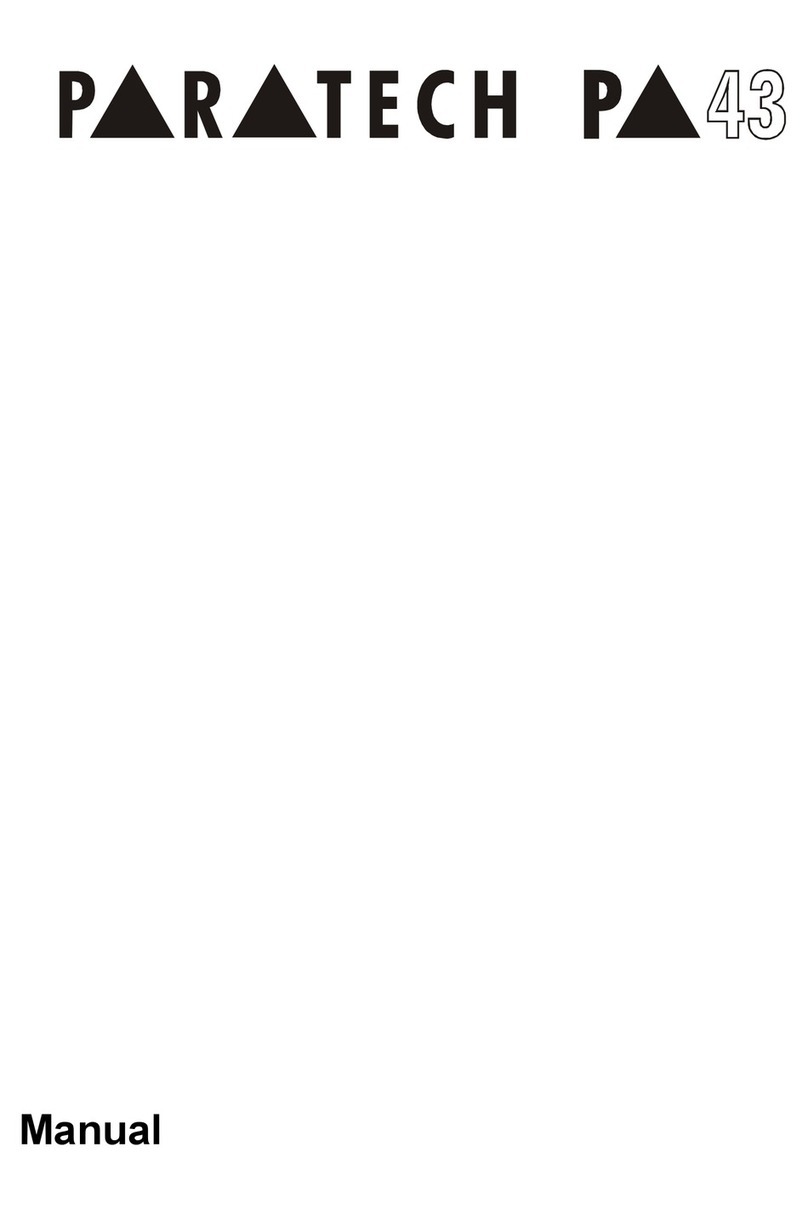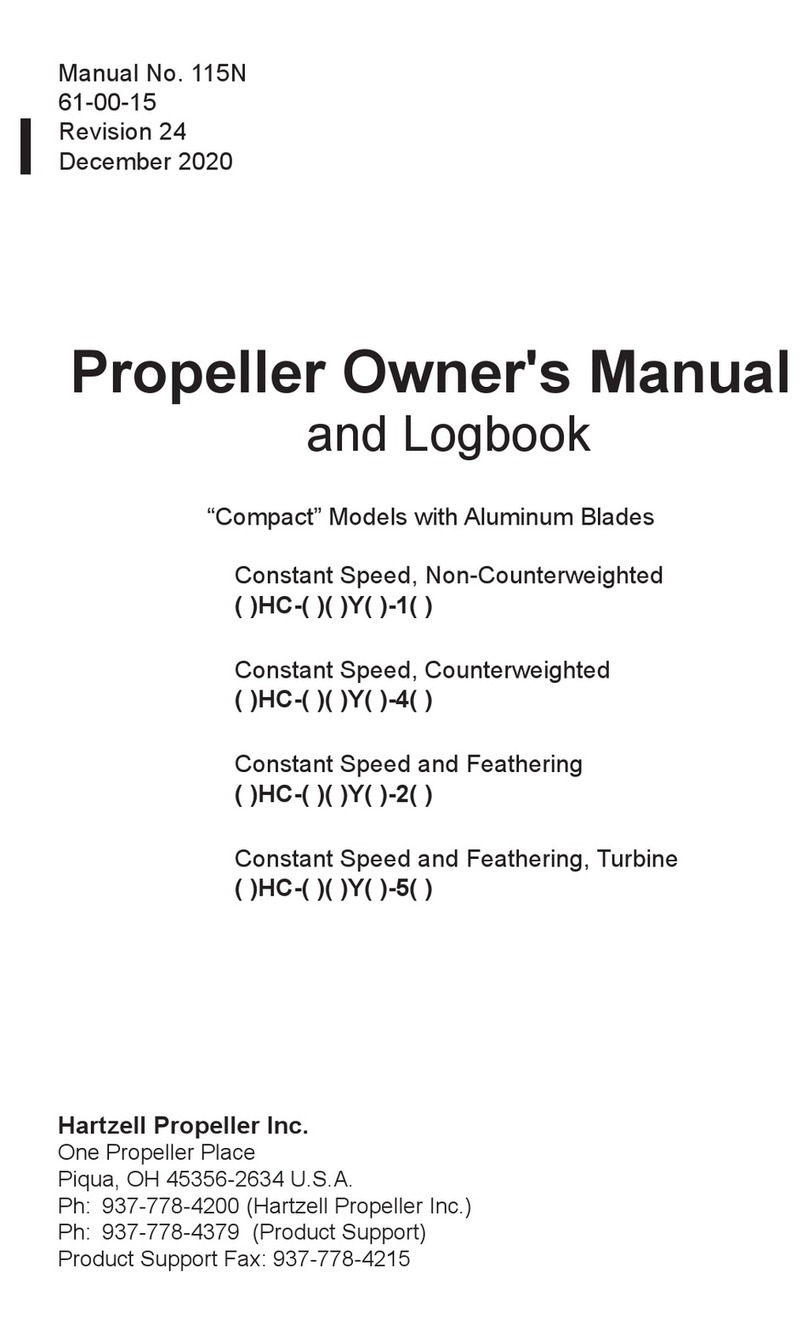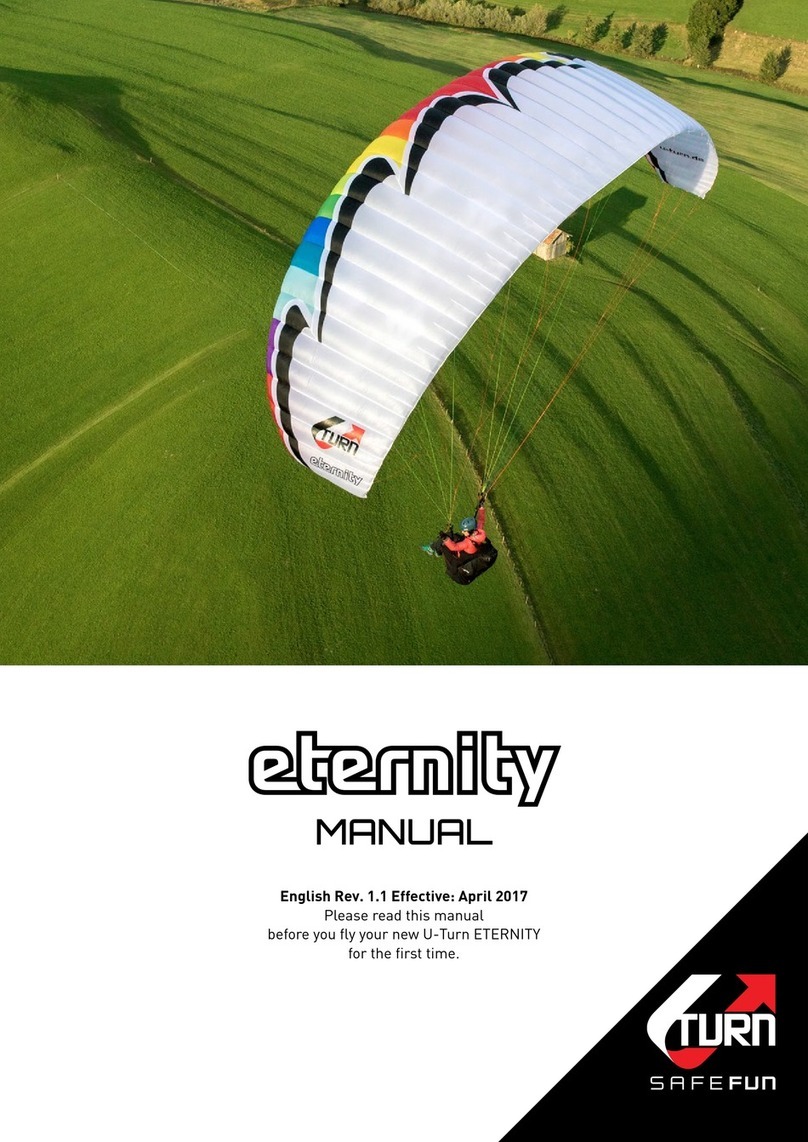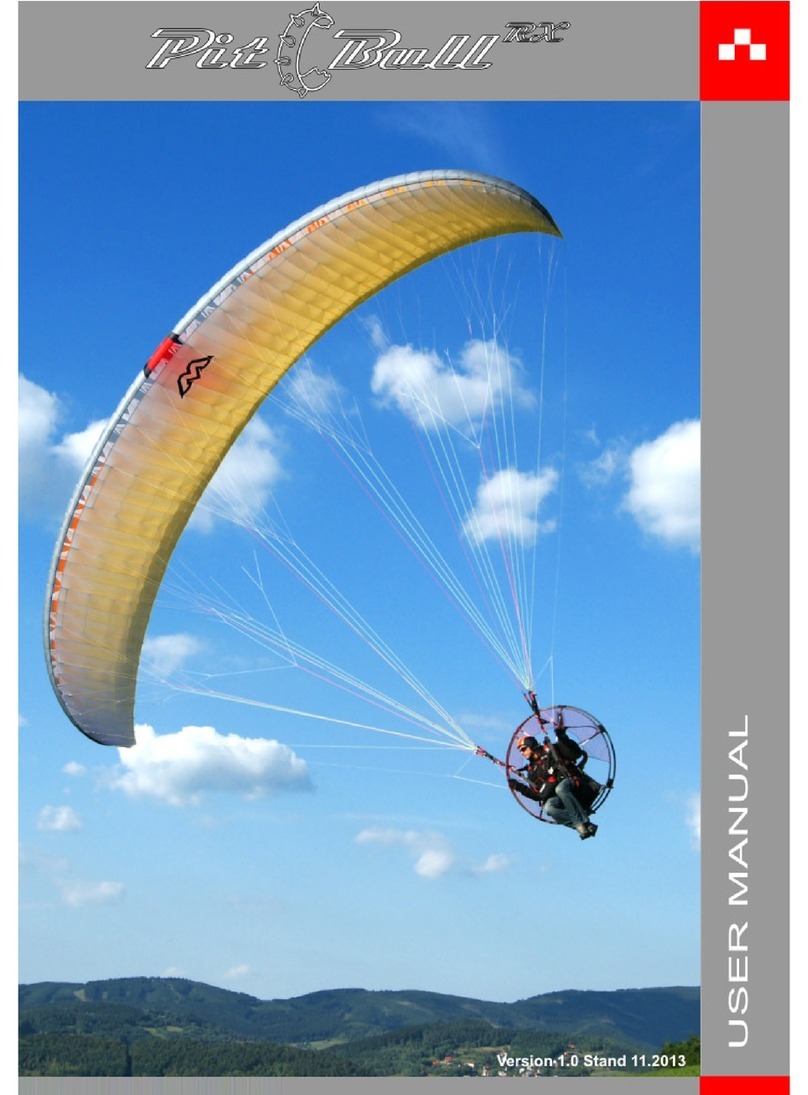NIVIUK GLIDERS KOYOT 5 P User manual

KOYOT
USER MANUAL

WELCOME
KOYOT
LIFT OFF TO ADVENTURE
We welcome you to our team and thank you for the
paraglider.
We would like you to share the enthusiasm with which
we have created this paraglider and the importance
and care with which we have developed the design
and manufacture of this new model. All this, in order
The KOYOT 5 P is an initiation, progression and
recreational glider that will allow you to join the
will soon discover the meaning of our motto:
“The importance of small details to make
great things happen”.
This is the user manual and we recommend you read
it carefully.
Niviuk Gliders & Air Games SL
C/ Del Ter 6 - nave D
+34 972 422 878
www.niviuk.com
Progression
Plume
Hike & Fly
2

USER MANUAL
This manual provides you with the necessary
information on the main characteristics of your new
paraglider.
Whilst it provides information on the wing, it cannot
be viewed as an instructional handbook and does
own system of licensing.
Only the aeronautical authorities of respective
countries can determine pilot competence.
The information in this manual is provided in order
to warn you against adverse flying situations and
potential dangers.
important to carefully read all the contents of your
new KOYOT 5 P manual.
injuries or death. The manufacturers and dealers
cannot be held responsible for misuse of the
paraglider. It is the responsibility of the pilot to
4
4
4
4
4
5
6
6
6
6
6
6
7
7
8
8
8
8
8
8
8
8
8
9
9
10
10
10
10
10
10
11
11
11
11
11
11
11
12
12
12
13
13
14
14
15
16
17
18
18
18
19
20
CONTENTS
1. CHARACTERISTICS
TAKEOFF
10. ANNEXES
3

CHARACTERISTICS
1.1 WHO IS IT DESIGNED FOR?
after flight!
you can gradually improve by taking advantage of the wing’s progressive responses.
and control.
1.2 CERTIFICATION
The load test proved that the wing can withstand the stipulated 8G.
Only the aeronautical authorities of respective countries can determine pilot competence.
We recommend pilots read the flight test report carefully, especially the comments of the test pilot. The
report contains all the necessary information on how the paraglider reacts during each of the tested
manoeuvres.
good collapse resistance in normal flight.
Designed for all pilots, including pilots under instruction.
pages of this manual or see or visit the Downloads section at www.niviuk.com
1.3 IN-FLIGHT BEHAVIOUR
make flying easier for the pilot.
To increase performance while maintaining the highest level of safety. To ensure that the wing transmits the
enjoying the flight. And, with active piloting, take advantage of all favourable conditions.
In all aspects of flight, the wing is very solid and stable. The glide is smooth, even when fully accelerated.
During glides, the wing maintains altitude and the wing remains stable. Improved turn precision means
handling is less physical and provides better feedback. Inflating the wing is much easier and gentler, without
overshooting.
Flying this wing is very intuitive, with clear and useful feedback about the airmass. It responds to the pilot’s
range of speed for incredible glides.
1.4 CONSTRUCTION, MATERIALS, TECHNOLOGIES
the current technology and accessories available to improve pilot comfort whilst increasing safety and
performance.
4

that we would like to introduce the technologies included in this new model:
RAM Air Intake
the same air flow at all angles to improve laminar flow. More consistency across the whole speed range and
better performance without compromising on safety.
Titanium Technology (TNT)
provides the highest level of protection against deformation, heat or breaks. The leading edge is more rigid
and the wing surface remains perfectly taut, without creases or parasitic drag. This optimises glide in all
Structured Leading Edge (SLE)
cutting system. Creating separate panels for each of the sections at the front of the wing means the sail fabric
shapes the leading edge panels. The fabric is guided by the panel position to ensure fewer creases and
durability.
flight comfort.
This program also paints the guideline markers and numbers on each individual fabric piece, thus avoiding
errors during this delicate process.
automation of this process.
The fabric used to manufacture the glider is light, resistant and durable. The fabric will not fade and is covered
by our warranty.
unsheathed Aramid.
specialists.
manufacturer.
manual.
1.5 ELEMENTS, COMPONENTES
paraglider:
5

2.1 CHOOSING THE RIGHT LOCATION
inflate the KOYOT 5 P.
2.2 PROCEDURE
Take the paraglider out of the rucksack, open and unfold it on the ground with the lines positioned on the
undersurface, oriented in the direction of inflation. Check the condition of the fabric and the lines for defects.
!
that there are no knots.
2.3 CONNECTING THE HARNESS
Correctly connect the risers to the attachment points so that the risers and lines are correctly ordered and
free of twists. Check that the carabiners are properly fastened and securely locked.
2.4 HARNESS TYPE
The KOYOT 5 P can be flown with all current harness types. We recommend setting the chest strap to the
handling of the glider. If the chest strap is too wide, it allows greater feedback but this carries the risk of
2.5 SPEED-BAR
pushed using the feet, the wing accelerates. The speed can be regulated by varying the pressure on the bar.
Once the pressure on the bar is released, the speed system returns to the neutral setting.
Please note!
The use of the speed system results in changes to the speed and reactions of the wing. For more
An inner bag to protect the wing during storage and transport.
An adjustable compression strap to compress the inner bag and reduce its volume.
A riser protector, which will prevent metal parts from coming into contact with
the cloth during storage.
A Kargo bag. It is not included in the pack, but we recommend to get it. This bag is large enough
6

2.5.1 SPEED SYSTEM ASSEMBLY
you must install it. Some considerations:
harness, personal preferences, etc.
To connect it to the harness, please follow the instructions of the harness manufacturer. The
connection system that is safe may be used.
much less weight.
2. Apply tension to both sides until the knots are locked tightly in the riser connections.
used in other systems or connection elements.
2.5.2 CHANGING THE RISER CORDS
or restrictions which is very useful for some models of harnesses.
2.6 INSPECTION AND WING INFLATION ON THE GROUND
After your gear has been thoroughly checked and the weather conditions deemed favourable for flying,
inflate your KOYOT 5 P as many times as necessary to familiarise yourself with its behaviour. Inflating
just accompany the natural rising movement of the wing. Once the wing is inflated to the overhead position,
2.7 ADJUSTING THE BRAKES
The length of the main brake lines are adjusted at the factory and conform to the length stipulated during
7

3.1 CHOOSING THE RIGHT LOCATION
supervising the entire procedure.
3.2 PREPARATION
3.3 FLIGHT PLAN
3.4 PRE-FLIGHT CHECK
of your gear with the wing fully open, the lines untangled and properly laid out on the ground to ensure that all
3.5 WING INFLATION, CONTROL AND TAKEOFF
IN FLIGHT
3.6 LANDING
3.7 PACKING
over time. Make sure the reinforcements are not bent or folded. It should not be folded too tightly to avoid
maintain the integrity of the leading edge and its internal structures in perfect condition.
and the reinforcements of the internal structure are kept in perfect condition.
THE FIRST FLIGHT
The report contains all the necessary information on how the KOYOT 5 P reacts during each
of the tested manoeuvres.
of the wing may vary.
Having the knowledge that the testing house provides through the test report is fundamental to learning how
to deal with possible situations.
8

restoring the wing’s default air speed and angle of attack by progressively reducing the tension on the brake
greater than 360o
appears to be fully inflated. To regain normal air speed, release brake line tension symmetrically and manually
The possibility of the KOYOT 5 P stalling during normal flight is very unlikely. It could only happen if you are
rearward and then reposition itself overhead, rocking slightly, depending on how the manoeuvre is done.
important to maintain brake pressure until the glider has returned to its default overhead flying position.
To resume normal flight conditions, progressively and symmetrically release the brake line tension to regain
air speed. When the wing reaches the overhead position, the brakes must be fully released. The wing will
pull both brake handles down to bring the wing back up and release them immediately while the glider is still
in transition to reposition itself overhead.
4.1 FLYING IN TURBULENCE
degree of passive safety, even in turbulent conditions.
All paragliders must be piloted for the prevailing conditions and the pilot is the ultimate safety factor.
We recommend active flying in turbulent conditions, always taking measures to maintain control of the wing,
4.2 POSSIBLE CONFIGURATIONS
To become familiar with the possible incidents described below, we recommend practising within the
the tested manoeuvres. Having this information is crucial to know how to react during these incidents in real
flight, so you can deal with these situations as safely as possible.
asymmetrically, especially if you do not fly actively and prevent the collapse. In this case the glider conveys
the collapse does happen, the KOYOT 5 P will not react violently, the turning tendency is gradual and easily
Due to the KOYOT 5 P’s design, in normal flying conditions frontal collapses are unlikely to take place. The
default glider air speed.
A negative spin does not conform to the KOYOT 5 P’s normal flight behaviour. Certain circumstances
9

Cravat
A cravat may happen after an asymmetric collapse, when the end of the wing is trapped between the lines.
Depending on the nature of the tangle, this situation could rapidly cause the wing to spin. The corrective
applying tension on the opposite brake and weight shift opposite to the turn. Then locate the 3STI stabilo line
may not be possible to continue on the intended flight path.
Over-controlling
unpredicted incidents. We should note that the wrong inputs can lead to loss of control of the glider. The
Generally speaking, the reactions of the wing, which are caused by too much input, are due to the length of
speed and attitude after any type of incident.
4.3 ACCELERATED FLIGHT
establish the air speed after correcting the angle of attack.
considered to be ‘active piloting’.
4.4 FLYING WITHOUT BRAKE LINES
If, for any reason at all, the KOYOT 5 P’s brake lines become disabled in flight, it will become necessary to
4.5 LINE KNOT(S) IN FLIGHT
descent method will depend on the particular situation.
To become familiar with the manoeuvres described below, we recommend practising within the environment
5.1 BIG EARS
Keep the ears pulled in until you have lost the desired altitude.
the other. We recommend inflating the wing tips asymmetrically, without major change to the angle of attack,
especially when flying near the ground or flying in turbulence.
5.2 B-LINE STALL
control of the paraglider.
LOSING ALTITUDE
10

Initiating the maneuver is physically demanding because it can take some strength to pull the risers down until
5.3 SPIRAL DIVE
this manoeuvre at high altitude and with enough ground clearance.
intensity of the turn can be controlled by braking slightly using the outer brake handle.
momentarily applying tension to the outer brake handle opposite to the turn. The pilot must also weight shift
and lean towards the opposite side of the turn at the same time.
noted.
how the manoeuvre was carried out.
5.4 SLOW DESCENT TECHNIQUE
6.1 TOWING
6.2 ACROBATIC FLIGHT
We do not recommend using this glider for acrobatic flying!!!
7.1 MAINTENANCE
CARE AND MAINTENANCE
11

!
using only water. Do not use detergents or other chemicals.
Direct sunlight may damage the wing’s materials and cause premature aging. After landing, do not leave the
If you fly in sandy areas, avoid getting sand in the cells or down into the trailing edge. At the end of the flight,
empty any sand that is in your wing. The openings at the end of the wingtips make this much easier.
If your wing is wet from contact with salt water, immerse it in fresh water and dry it away from direct sunlight.
7.2 STORAGE
solvents, fuels, oils.
more complicated and costly to repair.
temperatures up to 60oC.
It is very important to pack the wing correctly before storage.
7.3 CHECKS AND INSPECTIONS
Inspections
The KOYOT 5 P must be periodically serviced. An inspection must be scheduled every 100 flying hours or
7.4 REPAIRS
Please refer to the line plan at the end of this manual.
should inspect these and act accordingly.
12

person who is practicing it.
Manufacturers and dealers cannot be held responsible for your decisions, actions or accidents that may
result from participating in this sport.
GARANTEE
13

TECHNICAL DATA
COLORS
ANNEXES
22 24 26 28
CELLS NUMBER 39 39 39 39
ASPECT RATIO FLAT 4,7 4,7 4,7 4,7
AREA FLAT m2 22 24 26 28
PROJECTED m2 18,92 20,62 22,24 23,99
SPAN FLAT m 10,27 10,72 11,13 11,56
CORD MAXIMUM m 2,66 2,77 2,88 3
LINES TOTAL m 213 223 233 242
MAIN 2+1/3/2 2+1/3/2 2+1/3/2 2+1/3/2
RISERS NUMBER 3+1 A+A'/B/C A+A'/B/C A+A'/B/C A+A'/B/C
ACCELERATOR mm 130 130 130 130
TOTAL WEIGHT IN FLIGHT MIN-MAX kg 45-70 60-80 75-95 90-115
GLIDER WEIGHT kg 3,2 3,5 3,8 4,1
CERTIFICATION EN/LTF A EN/LTF A EN/LTF A EN/LTF A
14

70000 E3H
LKI - 10
W-420
DC - 60
TNL - 80
TNL - 220
TNL - 280
RISERS
3455
210D
V138
15

16

17

AC D
16155 6051 6105 6221 7091
26122 6017 6075 6191 6755
36082 5987 6051 6162 6627
46045 5955 6024 6128 6 474
55983 5916 6005 6111 6304
65872 5817 5894 5986 6317
75804 5771 5868 5938 6369
85625 5576 5485 6227
95388 5417 6082
10 5990
B C
470 470 470 470
340 340 383 470
AC D
15873 5776 5825 5935 6769
25839 5741 5795 5907 6447
35799 5709 5769 5876 6324
45763 5677 5743 5842 6177
55702 5637 5724 5825 6013
65595 5542 5617 5705 6024
75530 5498 5592 5659 6076
85358 5311 5224 5940
95131 5159 5801
10 5712
B C
470 470 470 470
340 340 383 470
18

AC D
16427 6317 6375 6495 7397
26394 6283 6346 6467 7049
36354 6254 6322 6438 6916
46317 6222 6295 6402 6759
56253 6183 6277 6386 6583
66138 6081 6161 6257 6597
76068 6034 6134 6207 6652
85882 5831 5736 6504
95636 5666 6355
10 6259
B C
470 470 470 470
340 340 383 470
AC D
16688 6573 6634 6759 7693
26655 6539 6606 6731 7333
36615 6512 6582 6703 7196
46578 6480 6555 6667 7034
56513 6440 6538 6657 6852
66394 6334 6419 6524 6868
76322 6286 6391 6473 6925
86129 6076 5977 6773
95873 5904 6618
10 6519
B C
470 470 470 470
340 340 383 470
19

Classification: A
In accordance with standards EN 926-
1:2015, EN 926-2:2013 and NfL 2-565-20: PG_1943.2022
Date of issue (DMY): 28.02.2022
Manufacturer: Niviuk Gliders / Air Games S.L.
Model: Koyot 5 P 24
Serial number: OIKT4242V1
Configuration during flight tests
Sticker generated automatically by AIR TURQUOISE SA, valid without signature // Rev 05 | 19.02.2021 // ISO | 91.21 // Page 1 of 1
Paraglider Accessories
Maximum weight in flight (kg) 80 Range of speed system (cm) 13
Minimum weight in flight (kg) 60 Speed range using brakes (km/h) 15
Glider's weight (kg) 3.5 Total speed range with accessories (km/h) 21
Number of risers 3Range of trimmers (cm) 0
Projected area (m2) 20.45
Harness used for testing (max weight) Inspections (whichever happens first)
Harness type ABS every 24 months or every 100 flying hours
Harness brand Advance Warning! Before use refer to user's manual
Harness model Success 4
M
Person or company having presented the
glider for testing: None
Harness to risers distance (cm) 44
Distance between risers (cm) 40
1
A
2
A
3
A
4
A
5
A
6
A
7
A
8
A
9
A
10
A
11
A
12
A
13
A
14
A
15
A
16
A
17
A
18
A
19
A
20
A
21
A
22
A
23
0
Classification: A
In accordance with standards EN 926-
1:2015, EN 926-2:2013 and NfL 2-565-20: PG_1942.2022
Date of issue (DMY): 28.02.2022
Manufacturer: Niviuk Gliders / Air Games S.L.
Model: Koyot 5 P 22
Serial number: OIKT4222V1
Configuration during flight tests
Sticker generated automatically by AIR TURQUOISE SA, valid without signature // Rev 05 | 19.02.2021 // ISO | 91.21 // Page 1 of 1
Paraglider Accessories
Maximum weight in flight (kg) 70 Range of speed system (cm) 14
Minimum weight in flight (kg) 45 Speed range using brakes (km/h) 15
Glider's weight (kg) 3.2 Total speed range with accessories (km/h) 21
Number of risers 3Range of trimmers (cm) 0
Projected area (m2) 18.75
Harness used for testing (max weight) Inspections (whichever happens first)
Harness type ABS every 24 months or every 100 flying hours
Harness brand Supair Warning! Before use refer to user's manual
Harness model Altiplume
S
Person or company having presented the
glider for testing: Nef Olivier
Harness to risers distance (cm) 44
Distance between risers (cm) 40
1
A
2
A
3
A
4
A
5
A
6
A
7
A
8
A
9
A
10
A
11
A
12
A
13
A
14
A
15
A
16
A
17
A
18
A
19
A
20
A
21
A
22
A
23
0
20
Table of contents
Other NIVIUK GLIDERS Aircraft manuals

NIVIUK GLIDERS
NIVIUK GLIDERS IKUMA Series User manual

NIVIUK GLIDERS
NIVIUK GLIDERS SKIN 2 User manual

NIVIUK GLIDERS
NIVIUK GLIDERS PEAK 5 User manual

NIVIUK GLIDERS
NIVIUK GLIDERS SKIN 3 User manual

NIVIUK GLIDERS
NIVIUK GLIDERS IKUMA 2 P User manual
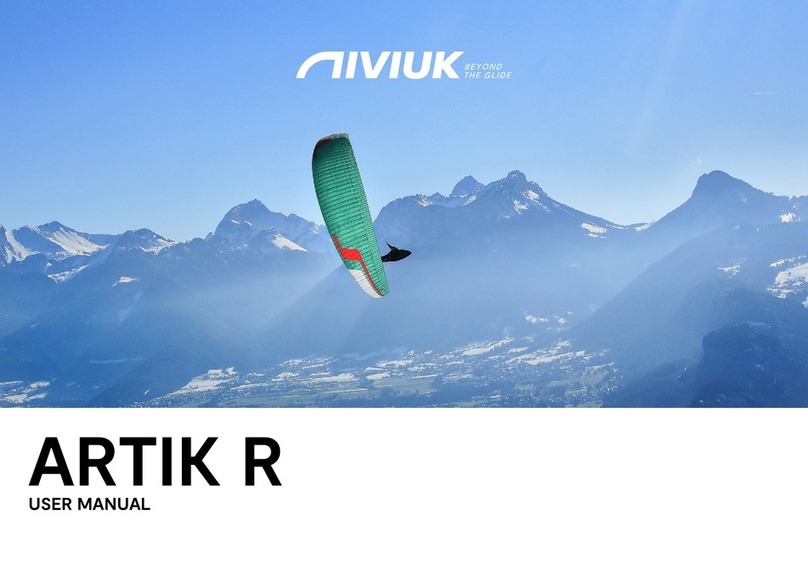
NIVIUK GLIDERS
NIVIUK GLIDERS ARTIK R User manual

NIVIUK GLIDERS
NIVIUK GLIDERS KOYOT 5 User manual


